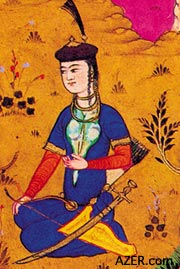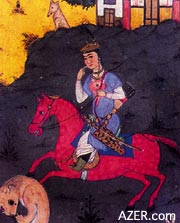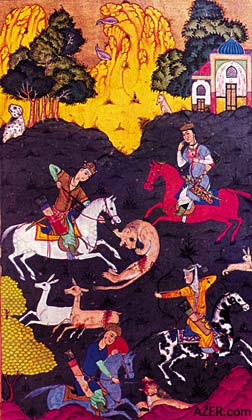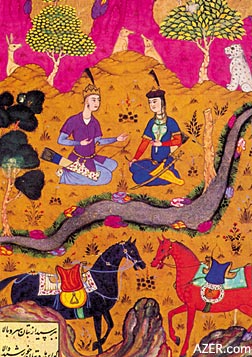|

Spring 2005 (13.1)
Pages
74-77
Amazons
Legends in History
Fearless Women Warriors in Life and Lore
by
Farid Alakbarli
  Legends
about the Amazons - a warlike tribe of women warriors - have
existed in various cultures throughout the world. Not many people
realize, however, that Amazons are closely associated with Azerbaijan.
Yes, ancient Greeks believed that Caucasian Albania was the native
land of the Amazons. Perhaps, much of what has been written about
Amazons is only a legend; however, it is true that many Albanian
women really did serve in the armies of Caucasian Albania when
they fought against the Roman invaders during the 1st century
BC. Legends
about the Amazons - a warlike tribe of women warriors - have
existed in various cultures throughout the world. Not many people
realize, however, that Amazons are closely associated with Azerbaijan.
Yes, ancient Greeks believed that Caucasian Albania was the native
land of the Amazons. Perhaps, much of what has been written about
Amazons is only a legend; however, it is true that many Albanian
women really did serve in the armies of Caucasian Albania when
they fought against the Roman invaders during the 1st century
BC.
Kingdom of Caucasian
Albania
Caucasian Albania was a territory that covered most of entire
region of modern-day Azerbaijan Republic including some additional
areas in neighboring countries. Note that Caucasian Albania had
nothing to do with the modern state of Albania in the Balkans.
According to legends, the kingdom of Caucasian Albania was founded
in the 4th century BC by king Aran. There were 26 different tribes
in Albania including Udi, Sodi, Gargar (Gagarians) and Gardman.
Strabo describes Caucasian Albanians as tall, blonde-haired and
gray-eyed. He characterizes them as brave and warlike. Albania
was a fertile agrarian state with vast wheat fields, grape vineyards
and fruit gardens. People worshiped the moon and various stars
and planets. There was a Temple dedicated to the Moon located
in the vicinity of Gabala in northern Azerbaijan, which was the
ancient capital of Albania.
Sometime during the 4th-5th century AD, Albania adopted Christianity.
Today we know about Albania from ancient Greek and Roman historians
such as Pliny (23 AD to 79 AD), Ptolemy (100 AD to 170 AD), Strabo
(64/63 BC to 23 AD), Plutarch (46 AD-after 119 AD).
Strabo and Albanian
Amazons
  Left: Note the apparel of th woman typical
of Amazons, wearing a sword and two cases of ski - one to hold
her bow and the other, her arrows. Left: Note the apparel of th woman typical
of Amazons, wearing a sword and two cases of ski - one to hold
her bow and the other, her arrows.
For example,
a little explicitly Strabo is reporting: "Also the Amazons,
it is said, live in the mountains of the Caucasian Albania. Theophanes,
who took part in Pompeius campaign (106 BC-48 BC) and marched
on the country of the Albanians, says that the Geles and the
Leges - Scythians - lived between the Amazons and the Albanians.There
was a river called Mermadalis, running between these tribes and
the Amazons. Others, however, among whom were Metrodorus the
Sceptic, and Hypsicrates, who were also familiar with these regions,
wrote that the Amazons lived near the border with Gagarians in
the northern promontories of the Caucasus called the Ceraunian
Mountains.
Strabo writes: "The Amazons spend their time isolated from
men, occupying themselves with plowing and sowing, planting,
taking their herds to pasture and, especially, in breeding horses.
The more courageous among them engage in hunting on horseback
and exercise martial arts.
"In their youth, all of these women have had their right
breast cut off to enable a more effective use of their right
arm, especially in throwing the javelin. They also make use of
the bow, the axe, and a light buckler (a shield worn on the arm).
They prepare helmets, clothing, and waist belts from animal skins.
"In the spring, they celebrate two special months, when
they climb the nearby mountains which separate them from the
Gagarians. Following an old custom, the Gagarians meet them there
and carry out sacrifices with the Amazons. Then they unite to
procreate children. They do it secretly in the dark - every Gagarian
with the Amazon women that they choose. After the women become
pregnant, they return. The female children who are born to the
Amazons are kept, but the boys are passed over to the Gagarians
to raise. Each Gagarian who is given a child raises it as his
own son, despite the uncertainty of its origin."
Gagarians and Amazons
The
Gagarians about which Strabo writes were one of main tribes of
the Caucasian Albania. In other sources they are called Gargarians
or the Gargar people. Together with the Udi people, Gagarians
/ Gargarians were the most important tribe in the region. The
province where they lived was called Gargarian Lowland (now known
as Mugan steppe in Azerbaijan).
But who were the Amazons? Despite the fact that Strabo's story
is, obviously, part fantasy, part legend, it may offer some basis
for fact. For example, it states that there were two neighboring
tribes in Caucasian Albania: the Amazons and Gagarians. Of course,
it is hard to believe that Amazons consisted only of women. More
than likely, it was a tribe with strong traces of matriarchy,
where women served as warriors and chiefs of tribes. So the Amazons
and Gagarians may have been people of different cultures and
traditions and, perhaps, with different languages and racial
peculiarities.
Plutarch's Amazons
  Left:
From
Miniatures of Nizami's Poetry (Baku, Yazichi 1983). Left:
From
Miniatures of Nizami's Poetry (Baku, Yazichi 1983).
In 66 BC, the
Roman legions marched on the Caucasus, hoping to be able to easily
overtake and conquer this mountainous region. The Roman army
was headed by the distinguished General Pompey (Gnaeus Pompeius
Magnus, 106-47 BC). Orois, the king of the Caucasian Albania,
made a fearless attack on the Roman legions. The Albanian army
numbering about 40,000 warriors, was defeated by Romans.
The next battle took place at the Alazan (Ginikh) River in the
region that is now known as northwest Azerbaijan. This time,
the Albanian army was commanded by the king's brother Cosis.
His troops encountered 22,000 in cavalry (including the so-called
"Amazons") and 60,000 in infantry. During this bloody
battle, Cosis pressed the Roman warriors and got near Pompey
himself. The Roman historian Plutarch (circa 45-125 AD) in his
"Life of Pompey" writes: "Their general was Cosis,
the king's brother, who as soon as the battle had begun, singled
out Pompey, and rushed at him, thrusting his javelin into the
joints of his breastplate. However, Pompey, succeeded in retaliating,
pierced him through the body with his lance, and slew him. In
this battle, the Amazons were fighting together with the barbarians
(Albanians). They had come down from the mountains from the river
Thermodon".
After killing Cosis, the Romans took the offensive. Even though
the Albanian troops retreated to mountains around Gabala and
Shaki, they continued their resistance, with surprise attacks
against the Romans in various parts of the country. Again, it
was the Amazons who played an important role in these attacks.
Soon, most of Romans were either killed or wounded. Others starved
because the Albanians had scorched their food supply - their
own fields of crops and fruit gardens. As a result, Pompey could
not reach the Caspian shores and so he returned to Iberia (modern
Georgia), which the Romans had captured earlier. Unlike Armenia
and Iberia, Caucasian Albania was never conquered by the Roman
Empire. Amazons had played an invaluable role in this resistance.
The Amazon Race
This very important question of the identity of the Amazons still
puzzles modern historians. It is interesting that among peoples
living in Albania, Strabo mentions Scythians and points out that
they lived in the vicinity with Albanians and Amazons. From history,
we know about women warriors among the Scythians, Sakas and Sarmatians.
These peoples had related traditions, which were very similar.
Scythian-Saka women were known to have fought on horseback in
their cavalries.
From ancient times, these related peoples had lived in Caucasian
Albania and other areas of Azerbaijan. During the 8th-7th century
BC, Scythians created their own kingdom in Azerbaijan. Sakas
also settled in Azerbaijan at this time. One of the provinces
of the Caucasian Albania was named Sakasena which means "Land
of Saka". Today one of the ancient cities located in the
foothills of the Caucasus mountains in northwest Azerbaijan is
called "Shaki", a name that is related to the Saka
people. Later, Scythians intermarried with Albanians and other
tribes of ancient Azerbaijan. All of them are ancestors of modern
Azerbaijanis.
  Left:
"Khosrov
and Shirin Meet While Hunting". Note the woman on horseback
has skillfully shot the deer with her bow and arrows. Another
has pierced a lion with her sword. From Miniatures of Nizami's
Poetry. (Baku, Yazichi 1983). Left:
"Khosrov
and Shirin Meet While Hunting". Note the woman on horseback
has skillfully shot the deer with her bow and arrows. Another
has pierced a lion with her sword. From Miniatures of Nizami's
Poetry. (Baku, Yazichi 1983).
In the 1st century
BC, the Sakas of Azerbaijan were a semi-nomadic warlike tribe
with evidence of matriarchy in their culture. The Saka women
had many rights and served in the army as cavalry women. The
Greek historian Ctesius (5th century BC) writes: "The Saka
women are brave and help their husbands in war".
However, not all Saka women participated in battles. Mostly,
it was the young and unmarried girls who were specially trained
in archery, wrestling, horse-riding and fencing. The elevated
status of women is proven by the fact that in Sarmatian burial
mounds, the queen is often placed in the center of the grave,
while the men servants were buried around her. Ancient Greeks
called the ruling system of Sarmatians and Sakas "Gynocracy"
(society ruled by women). Zarina and Sparetra were famous Saka
queens. It is believed that the legends about Amazons stem from
these practices among the Sarmatians or Sakas.
Perhaps, the Sakas are those Amazons mentioned in Strabo's "Geography".
It is important that Strabo and Plutarch both wrote that the
Amazons lived in Caucasian Albania, but that they never mention
that Amazons and Albanians were similar or related peoples.
Plutarch writes that Amazons helped Albanians to fight against
the Romans. The Albanian king would ask help from the neighboring
Saka tribes and sent their cavalry - both men and women on horseback
- to fight against Romans. It may be that the men and women of
Saka were divided into different detachments.
Perhaps, the Romans saw troops that were comprised only of women.
It's only natural that when the Romans saw armed women on horseback,
they were surprised and concluded that they had met the real
Amazon tribes. Perhaps this is why they describe the Saka men
warriors as Scythians, and Saka women warriors as Amazons.
Queens of Turan
In ancient
Iranian sources, Scythians, Sakas and Sarmatians are called "Turanians".
The great Persian poet of the 9th century Ferdowsi wrote in his
"Shahname" (Book of the King) about war between agrarian
Iranians and nomadic Turanians. Iranians lived in cities and
villages and they were patriarchal; their women had few rights.
However, Turanians were nomads and lived horseback. In contrast
to the Iranians, they had strong traces of matriarchy. Turanian
women participated in wars and often they were ruled - not by
kings, but queens - such as the famous Turanian (Massagat) queen
known as Tomris.
References to Queens can also be found in the poem, "Khosrov
and Shirin" by 12th century Azerbaijani poet Nizami Ganjavi.
For example, he writes about Shirin, the Christian queen and
wife of the Sasanid king Khosrov II (590-628). There are different
versions about ethnic origin of Shirin (Syrian, Armenian, Caucasian
Albanian, Aramaic, Western Iranian). Nizami writes that legends
about queen Shirin were held in the city of Barda (located in
central Azerbaijan). It is important to note that in the times
of which Nizami writes (Sasanid Iran, 2nd-4th century AD), Barda
was the capital of the kingdom of Caucasian Albania. Shirin was
characterized as a brave woman who rode a horse. In other words,
she had all the characteristics of being an "Amazon".
Another legendary queen of Barda that Nizami wrote about was
Nushaba who lived during the times of Alexander the Great (356-323
BC). Despite the fact that historical sources have not been found
that tell us about this Albanian queen, her prototype may have
been a Saka chief (queen) from Sakasena, the autonomous province
of Albania. Both Nushaba and Tomris are typical queens of Turan
- Amazons.
Turkic Cavalry
Women
  Left:
From the
"First Conversation of the Lovers", Miniatures of Nizami's
Poetry (Baku, Yazichi 1983). Left:
From the
"First Conversation of the Lovers", Miniatures of Nizami's
Poetry (Baku, Yazichi 1983).
Sakas and Scythians
lived in Azerbaijan from the 1st millennium BC until first centuries
of the Christian Era. Then, they became assimilated by the local
population. During the first centuries AD, other nomadic peoples,
the Oghuz, Seljuks and Kipchaks arrived in Azerbaijan. The traditions
among these semi-nomadic tribes were similar to each other. These
three groups have been found to have traces of matriarchy in
their culture. During the Middle Ages, both the Scythians-Sakas
and Oghuz-Kipchaks were considered Turanians and women warriors
were typical to all of them.
In medieval Azerbaijani and Iranian manuscripts, we see miniatures
painted with images of armed women fighting on horseback. In
the medieval Azerbaijani epic "Kitabi-Dada Gorgud"
(11th century AD), we read about such women warriors as Burla
khatun and Banuchichak. Women of the Turk Oghuz also were armed
and fought on horseback. Detachments of women resembling Amazons
also existed.
In this epic, we read about the wife of Dirse khan, the king
of Oghuz: "Dirse khan's wife had returned back home. She
did not yield and she armed 40 maidens, acquired horses for them
and led them herself. She mounted a swift-footed horse and went
to look after her son". These 40 armed maidens led by the
Oghuz queen are the real Amazons.
From these facts, we may conclude that the information about
Amazons in ancient Greek sources is not pure fantasy. The prototypes
of Amazons - the Scythian-Saka and Oghuz-Kipchak tribes - really
lived in the ancient and medieval Azerbaijan.
In the miniatures depicted these stories we find images of Shirin
and others. They are equipped for battle - with swords, bows,
arrows and shields. However, their appearance is peaceful. Only
some of the cavalry women shooting appear warlike and aggressive.
In contrast to the European-faced Shirin in this miniatures,
the cavalry women have a slightly Mongoloid appearance (slanted
eyes), typical of the Kipchak nomads who were a group of Turkic
tribes living in the Eurasian steppes between Mongolia and Siberia
and the Caucasus. For example, Afag (pronounced ah-FAGH), the
wife of Nizami was also a Kipchak. The king of Kipchaks, known
as Kipchak Malik and his daughter Seljan are described in the
medieval Azeri epic Dada Gorgud. So, in these miniatures, we
see two types of Amazons: (1) the Turanian Saka type (Queen Shirin),
and (2) the Turkic Kipchak type (cavalry women on horseback,
shooting).
There was also a third type of Amazons - the Turkic Oghuz woman
warriors. The Oghuz tribes lived throughout Azerbaijan. They
comprise the main ancestors of modern Azerbaijanis today. During
the first centuries AD, Oghuz intermarried with Sakas, Albanians
and Medes. They rarely had slanted eyes. They looked almost like
modern Azerbaijanis.
The woman warriors of Oghuz (Burla khatun, Banuchichak and others)
are also described in Dada Gorgud. Unfortunately, we have no
ancient miniatures showing Burla khatun and Banuchichak in battle,
only modern day illustrations by Azerbaijani artists.
Amazons in Verbal
Folklore
Modern writers incorporate these folk epics and stories about
Amazons in their books and plays. In 1927, the famous Azerbaijani
playwright Jafar Jabbarli wrote a romantic historical novel entitled
"Od Gelini" (Fiancé of Fire) which depicts a
heroine struggling against Arab invaders of the eighth and ninth
centuries. The famous writer of Azerbaijan Anar simplified and
adopted the "Dada Gorgud stories" for children. Writer
Nabi Khazri wrote a play "Burla khatun, about the legendary
Oghuz queen and warrior Burla khatun, who participated in battles
with troops of armed Oghuz women.
Legends about Amazons are still quite prevalent in the verbal
folklore of Azerbaijan. Ashugs (folk minstrels who tell these
stories accompanying themselves on the traditional stringed instrument-saz)
are the real repositories of these legends. For example, some
of them still sing about the women warriors. Ashugs in the Gazakh
district (northwest Azerbaijan) sing of these feats from Dada
Gorgud in the squares, tea houses and cafes.
Banuchichak
Usually, the folk minstrels concentrate and improvise on specific
sections of these long epics. One of the most popular ones related
to Amazons is a story about Beyrek and Banuchichak. According
to this story, the Oghuz prince Beyrek wanted to marry Banuchichak,
a princess from another clan. Banuchichak was a skillful rider,
hunter, archer and wrestler. At last, he finds Banuchichak in
the royal tent in the steppe, but he doesn't recognize her because
Banuchichak disguises her personality.
The following discourse is said to have taken place: "What
is your business here, young man?" asked Banuchichak. "Bay
Bichan Bey is supposed to have a daughter. I've come to see her,"
replied the prince.
The girl said, "She's not the sort of person who would show
herself to you. But I'm her maid servant. Let's go hunting together.
If your horse can run faster than mine, then you can beat her
horse, too. Then we'll shoot arrows with our bows. If you can
shoot an arrow farther than I can, you can beat her at this,
too. Then, we'll wrestle. If you can defeat me, you can defeat
her, too." Beyrek agreed: "Very well, then. Let's mount."
The two got on their horses and rode out onto a field. They spurred
their horses, and Beyrek's horse outran the girl's. When they
shot their bows, Beyrek's arrows landed at a further distance
than the girl's. The girl noted: "Oh, young man, no one
has ever ridden faster than me, and no one has ever shot an arrow
further than mine. So let's wrestle."
Beyrek dismounts. They grappled with one another like two trained
wrestlers. Beyrek tried to knock the girl to the ground, while
she tried to make him lose his balance and fall. Exhausted, Beyrek
thought, "If I'm beaten by this girl, everyone will laugh
at me and say terrible things about me throughout the lands of
the Oghuz."
So he gathered his strength and finally threw the girl. He first
tripped her up and caught her by her breast while she struggled
to free herself. Then Beyrek took the girl by her narrow waist
and threw her down again, making her fall flat on her back.
The girl finally admitted: "Young man, I am Banuchichak,
daughter of Bay Bichan."
Beyrek kissed the girl three times. Then, taking the golden ring
from his own finger, he placed it on the girl's finger, and announced:
"May your wedding be a happy one, oh, daughter of a khan.
Let this be a sign of our engagement."
This and other stories from Dada Gorgud provide evidence that
ancient Amazon traditions continued to live in Azerbaijan even
up to the first stage of the Islamic Era (approximately 7th-15th
century AD).
Despite the fact that queens disappeared after the 7th century
when Islam was introduced into the region, evidence in folklore
suggests that women warriors sometimes existed in nomadic Turkic
tribes of Central Asia and Azerbaijan until 10th-12th centuries.
After that, this phenomenon seems to have disappeared, as well
even though both the mother and wife of the king Uzun Hasan Aghgoyunlu
(15th century) continued to play important part in governing
the country which at that time had its capital in Tabriz.
Stories about the Amazons were not just a figment of the imagination
amongst ancient Greek and Roman historians. Prototypes of the
Amazons really existed in vast plains of Eurasia which stretch
from Caucasus mountains of Azerbaijan and steppes of Ukraine
to the deserts of Mongolia. These mysterious Amazons were not
a separate nation or an unusual human race. They were regular
women who took on the role as warriors from very early times.
These facts provide the basis for the legends that have grown
up around the Amazons. Therefore, the Azerbaijan of antiquity
was known to historians outside the region, not only as "land
of fire", but also as the land of the "Amazons".
Back to Index AI 13.1 (Spring
2005)
AI Home
| Search | Magazine
Choice
| Topics
| AI Store | Contact us
Other Web sites
created by Azerbaijan International
AZgallery.org | AZERI.org | HAJIBEYOV.com
|





